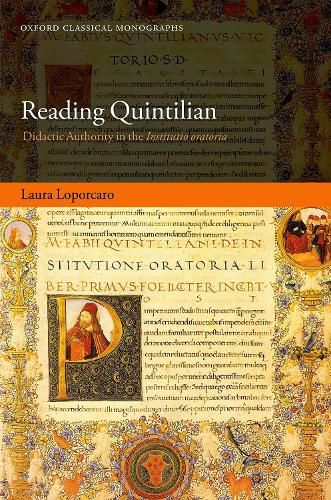Readings Newsletter
Become a Readings Member to make your shopping experience even easier.
Sign in or sign up for free!
You’re not far away from qualifying for FREE standard shipping within Australia
You’ve qualified for FREE standard shipping within Australia
The cart is loading…






Reading Quintiliantakes Quintilian's Institutio oratoriaas a coherent literary work: one worth reading in full. This book examines how didactic authority is created and how readers are guided through the Institutiothanks to an overarching framework that holds it together. This framework is composed of several leitmotifs: the author's self-staging, statements of didactic intent and method, the depiction of an ideal didactic constellation, remarks suggesting that the work proceeds in parallel with the pupil's training and the author's life, polemics against other authorities, and proleptic strategies deflecting responsibility for students' potential failures. As Reading Quintilianshows, the pervasiveness of that framework, and the implementation in the Institutioof the same rhetorical strategies it describes, indicate that the work is not a mere accumulation of precepts, but an artfully crafted whole. All the stops of rhetorical art are pulled out to engage readers and to persuade them that the teachings conveyed are valid. Laura Loporcaro grounds her analysis of the leitmotifs in the discussion of central themes, including Quintilian's reception of Cicero and Seneca the Younger, his conception of the ideal orator, and his polemic against 'corrupt' oratory. Combining a panoramic view with in-depth study of single leitmotifs and themes, Reading Quintilianinvestigates the construction, goals, and models of the Institutio, thereby shedding new light on the treatise as a whole.
$9.00 standard shipping within Australia
FREE standard shipping within Australia for orders over $100.00
Express & International shipping calculated at checkout
Reading Quintiliantakes Quintilian's Institutio oratoriaas a coherent literary work: one worth reading in full. This book examines how didactic authority is created and how readers are guided through the Institutiothanks to an overarching framework that holds it together. This framework is composed of several leitmotifs: the author's self-staging, statements of didactic intent and method, the depiction of an ideal didactic constellation, remarks suggesting that the work proceeds in parallel with the pupil's training and the author's life, polemics against other authorities, and proleptic strategies deflecting responsibility for students' potential failures. As Reading Quintilianshows, the pervasiveness of that framework, and the implementation in the Institutioof the same rhetorical strategies it describes, indicate that the work is not a mere accumulation of precepts, but an artfully crafted whole. All the stops of rhetorical art are pulled out to engage readers and to persuade them that the teachings conveyed are valid. Laura Loporcaro grounds her analysis of the leitmotifs in the discussion of central themes, including Quintilian's reception of Cicero and Seneca the Younger, his conception of the ideal orator, and his polemic against 'corrupt' oratory. Combining a panoramic view with in-depth study of single leitmotifs and themes, Reading Quintilianinvestigates the construction, goals, and models of the Institutio, thereby shedding new light on the treatise as a whole.